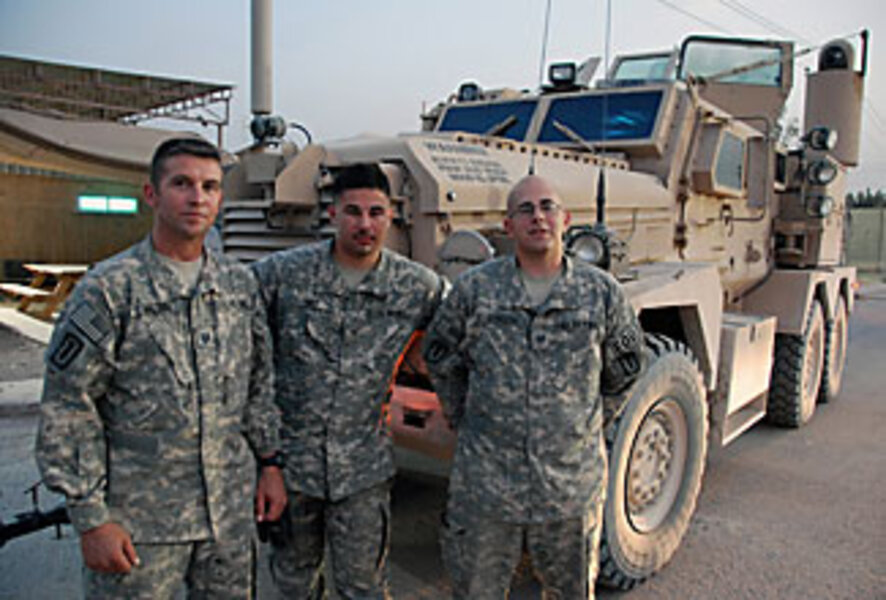U.S. begins hunting Iraq's bombmakers, not just bombs
| Baghdad
When members of the Air Force's 447th Explosive Ordnance Disposal unit first arrived here in May, they were dealing with three to four roadside bombs a week. During prior tours, the group's veterans say at least one a day was normal.
But last month, they went their first week without encountering a single roadside bomb.
For US soldiers in Iraq, this decline is perhaps the loudest herald of a quieter Iraq. It's also representative of the US military's greater strategic shift, focusing less on individual threats like improvised explosive devices (IEDs) and broadening their scope to the larger counterinsurgency mission.
"We've made a mistake focusing on IEDs as a technological threat," says Frederick Kagan, a military expert at the American Enterprise Institute. To defeat roadside bombs in Iraq, the military had to broaden their focus beyond the devices and look at them as a piece of the entire conflict. "As we've been winning the counterinsurgency, the effectiveness of IEDs has been wearing off," he says.
IEDs, the military's name for roadside bombs, have posed the biggest threat for most of the war, accounting for the death of more than half of all US servicemen killed in combat. But since the troop surge began earlier this year, which is also when the military began to place a greater emphasis on counterinsurgency tactics, US military officials say IED attacks have dropped by 70 percent.
Explosive ordnance disposal (EOD) technicians attribute the decline to a shift from targeting the devices alone to investigating and searching for entire bombmaking groups. Instead of simply detonating IEDs as soon as they found them, EOD teams began spending more time studying the devices, questioning locals, and trying to trace the bombs back to their source.
"We're more with gathering evidence, trying to preserve evidence, bring it back so we can try to do that CSI aspect," says SMSgt. Pervis King, a native of Cuero, Texas. "The way it has evolved since the war started, weapons intelligence teams now assist us with gathering evidence out on the battlefield so we can come back and try to prosecute the insurgents." Bombmakers often leave fingerprints and other biometric data that soldiers can use to find those behind the bombs.
While IEDs remain a considerable threat – coalition troops continue to strike or destroy between 190 to 220 IEDs every week and in August at least seven servicemen lost their lives in IED attacks, according to statistics compiled by the website iCasualties – many bomb networks are having a difficult time rebuilding after major Iraqi and coalition offensives, according to the US military.
"They can and have regenerated themselves, but they often don't come back with the same effectiveness," says US Army Col. Kevin Lutz, commander of the counter IED task force in central Iraq. Building and properly planting IEDs is a specialized skill, he says, and lately US forces are seeing increasing numbers of ineffective IEDs now that senior bombmakers or supplies have been apprehended or killed.
In the south of Iraq, a major Iraqi-led offensive this spring may have damaged cells that make specialized explosively formed penetrator (EFP) bombs that are designed to destroy armored vehicles. Traditionally, the south has been the main entry point for the devices coming from Iran, says Dr. Kagan, but even though weapons smugglers can get EFP-making materials into the country, this spring's offensive eliminated or broke up many cells they supplied.
"Iranians can in principle send supplies to whatever middlemen they have, but their ability to deploy those weapons has been degraded," says Kagan.
Most EOD technicians agree that the biggest change has come from the locals. A year ago, when US forces discovered an IED, most local Iraqis claimed to know nothing about it. Now, however, many EOD teams find many roadside bombs thanks to locals' tips.
"They're more willing to give us the information we need, whereas before they were scared for their families or what not," says US Air Force EOD technician TSgt. Ron Wilson.
Still, Colonel Lutz says, continuing to study IEDs remains a vital element of continuing to reduce the threat. The Pentagon provided $11.25 billion from 2004 to 2007 to deal with the IED threat. "As part of the counterinsurgency doctrine you have a counter-IED element, because it's the insurgent's weapon of choice."





